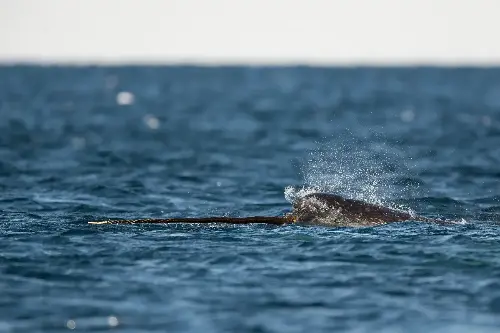Sailing through the icy waters of the Arctic, the narwhal, with its helical tusk, has long sparked the curiosity of both seafarers and scientists. Known as the "unicorn of the sea," this remarkable cetacean has been shrouded in mystique and folklore, often overshadowing the fascinating truths about its existence. Join us as we dive beneath the surface to explore the lesser-known aspects of the magnificent narwhal.
Narwhals, or Monodon monoceros, are medium-sized toothed whales and close relatives of the beluga whale. They possess a highly distinctive tusk, which is actually an elongated incisor that can reach lengths of up to 3 meters. While these tusks are typically found on males, around 15% of female narwhals also grow a smaller version. Scientific research has revealed that the tusk has sensory capabilities, with up to 10 million nerve endings inside, suggesting that it could be used to detect changes in the narwhal's environment, including the salinity of the water and the presence of other individuals.

Contrary to popular belief, the tusk is not used as a weapon for territorial disputes or for catching prey. Instead, it seems to play a role in mating rituals and social interaction. Males may use their tusks in displays of dominance and prowess to impress females or show superiority over other males, an aquatic dance of showmanship that ensures the strongest genes are carried forward.
But the narwhal's tusk isn't the only thing that makes it unique. Narwhals are capable of deep-sea dives, descending as deep as 1,500 metres to hunt for fish, squid, and shrimp. They can stay underwater for up to 25 minutes before needing to surface for air. These dives are not only impressive feats of endurance, but they are also strategic hunting expeditions, as this is where their preferred prey resides.
Speaking of residence, narwhals favour the cold waters of the Arctic and are rarely found outside this specialised habitat. They inhabit the Atlantic parts of the Arctic Ocean and the drift ice of the Canadian High Arctic, circling the polar waters in small, tight-knit groups called pods. This preference for cold waters has resulted in narwhals having a thick layer of blubber, which can be up to 10 centimetres thick, providing both buoyancy and insulation against the brutally cold temperatures.

Though they may be elusive to the average observer, narwhals have a special relationship with the Inuit people and feature prominently in their culture and legends. Narwhals are not just icons of mystery; they're a valuable source of food and materials in these communities. Every part of the narwhal is utilised; the meat is shared among community members, the blubber is used for oil, and the tusks are traded or crafted into tools and art.
Despite their captivating allure, narwhals face threats from multiple fronts. Climate change is a spectre looming over their icy habitat, with rising temperatures leading to diminishing sea ice and altered prey distributions. As the Arctic warms, the narwhal's environment changes in unpredictable ways, which could make it harder for these animals to find food and maintain their traditional migration patterns. Additionally, increased human activities in the Arctic, such as shipping and oil and gas exploration, pose potential risks through noise pollution and the possibility of environmental contamination.
Moreover, narwhals are also part of the complex ecosystem of the Arctic food web. Their role in balancing the ecological dynamics is intricate, as they are both predators and prey. As predators, they help to maintain healthy fish populations, but as prey, they are vital in the diets of polar bears, walruses, and killer whales.

Conservation efforts for narwhals are in place, but their mysterious lifestyle and remote habitat make research and protection challenging. International agreements such as the Agreement on the Conservation of Polar Bears and Their Habitat include narwhals by association, as any initiative that protects sea ice benefits the species that rely on the polar ecosystem.
In closing, the narwhal is a creature of both myth and reality. Its existence reminds us of the delicate balance of our ecosystems and the marvels of evolution. While research continues to unveil more about these enigmatic beings, one thing is clear: the narwhal, with its spiral tusk reaching to the skies, remains a sentinel of the Arctic—a testament to the wild and glorious complexities of nature. To protect the narwhal is to safeguard a legend, ensuring that future generations can marvel at these magnificent "unicorns of the sea."
